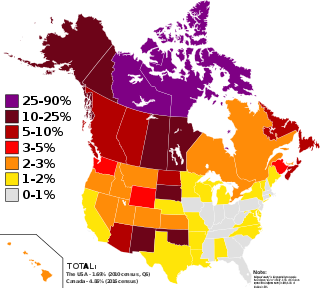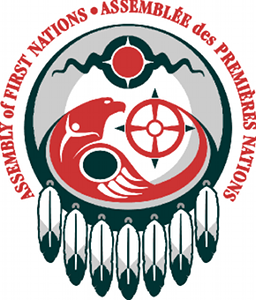Related Research Articles

Indigenous peoples in Canada are the Indigenous peoples within the boundaries of Canada. They comprise the First Nations, Inuit, and Métis. Although "Indian" is a term still commonly used in legal documents, the descriptors "Indian" and "Eskimo" have fallen into disuse in Canada, and most consider them to be pejorative. "Aboriginal" as a collective noun is a specific term of art used in some legal documents, including the Constitution Act, 1982, though in some circles that word is also falling into disfavour.

The Mi'kmaq are a First Nations people of the Northeastern Woodlands, indigenous to the areas of Canada's Atlantic Provinces, primarily Nova Scotia, New Brunswick, Prince Edward Island, and Newfoundland, and the Gaspé Peninsula of Quebec as well as Native Americans in the northeastern region of Maine. The traditional national territory of the Mi'kmaq is named Miꞌkmaꞌki.
First Nations is a term used to identify Indigenous peoples in Canada who are neither Inuit nor Métis. Traditionally, First Nations in Canada were peoples who lived south of the tree line, and mainly south of the Arctic Circle. There are 634 recognized First Nations governments or bands across Canada. Roughly half are located in the provinces of Ontario and British Columbia.

The Assembly of First Nations is an assembly of Canadian First Nations represented by their chiefs. Established in 1982 and modelled on the United Nations General Assembly, it emerged from the National Indian Brotherhood, which dissolved in the late 1970s.

The Métis are an Indigenous people whose historical homelands include Canada's three Prairie Provinces. They have a shared history and culture, deriving from specific mixed European and Indigenous ancestry, which became distinct through ethnogenesis by the mid-18th century, during the early years of the North American fur trade.
The Muskotew Sakahikan Enowuk or Lubicon Lake Nation is a Cree First Nation in northern Alberta, Canada. They are commonly referred to as the Lubicon Lake Nation, Lubicon Cree, or the Lubicon Lake Cree. This should not be confused with the Lubicon Lake Band #453, which is a separate entity created by the Government of Canada by Order in Council in 1973.
First Nations in Alberta are a group of people who live in the Canadian province of Alberta. The First Nations are peoples recognized as Indigenous peoples or Plains Indians in Canada excluding the Inuit and the Métis. According to the 2011 Census, a population of 116,670 Albertans self-identified as First Nations. Specifically there were 96,730 First Nations people with registered Indian Status and 19,945 First Nations people without registered Indian Status. Alberta has the third largest First Nations population among the provinces and territories. From this total population, 47.3% of the population lives on an Indian reserve and the other 52.7% live in urban centres. According to the 2011 Census, the First Nations population in Edmonton totalled at 31,780, which is the second highest for any city in Canada. The First Nations population in Calgary, in reference to the 2011 Census, totalled at 17,040. There are 45 First Nations or "bands" in Alberta, belonging to nine different ethnic groups or "tribes" based on their ancestral languages.

Thomas Eugene Flanagan is an American-born Canadian author, conservative political activist, and former political science professor at the University of Calgary. He also served as an advisor to Canadian prime minister Stephen Harper until 2004.

Delgamuukw v British Columbia, [1997] 3 SCR 1010, also known as Delgamuukw v The Queen, Delgamuukw-Gisday’wa, or simply Delgamuukw, is a ruling by the Supreme Court of Canada that contains its first comprehensive account of Aboriginal title in Canada. The Gitxsan and Wet’suwet’en peoples claimed Aboriginal title and jurisdiction over 58,000 square kilometers in northwest British Columbia. The plaintiffs lost the case at trial, but the Supreme Court of Canada allowed the appeal in part and ordered a new trial because of deficiencies relating to the pleadings and treatment of evidence. In this decision, the Court went on to describe the "nature and scope" of the protection given to Aboriginal title under section 35 of the Constitution Act, 1982, defined how a claimant can prove Aboriginal title, and clarified how the justification test from R v Sparrow applies when Aboriginal title is infringed. The decision is also important for its treatment of oral testimony as evidence of historic occupation.

The Bigstone Cree Nation is a First Nations band government in Alberta, Canada. As Woodland Cree, they are a western branch of the larger Cree nation, and are a party to Treaty 8 with Canada. The Bigstone Cree Nation was divided into two bands in 2010, with one group continuing under the former name, and the other becoming the Peerless Trout First Nation.

Canadian Aboriginal law is the body of law of Canada that concerns a variety of issues related to Indigenous peoples in Canada. Canadian Aboriginal Law is different from Canadian Indigenous law: In Canada, Indigenous Law refers to the legal traditions, customs, and practices of Indigenous peoples and groups. Aboriginal peoples as a collective noun is a specific term of art used in legal documents, including the Constitution Act, 1982, and includes First Nations, Inuit and Métis people. Canadian Aboriginal law provides certain constitutionally recognized rights to land and traditional practices. Canadian Aboriginal Law enforces and interprets certain treaties between the Crown and Indigenous people, and manages much of their interaction. A major area of Aboriginal law involves the duty to consult and accommodate.

The Aboriginal Peoples Television Network is a Canadian specialty channel. Established in 1992 and maintained by governmental funding to broadcast in Canada's northern territories, APTN acquired a national broadcast licence in 1999. It airs and produces programs made by, for and about Indigenous peoples in Canada and the United States. Based in Winnipeg, Manitoba, it is the first network by and for North American indigenous peoples.
Compulsory sterilization in Canada has a documented history in the provinces of Alberta, Saskatchewan, and British Columbia. It is still ongoing as in 2017, sixty Indigenous women in Saskatchewan sued the provincial government, claiming they had been forced to accept sterilization before seeing their newborn babies. In June 2021, the Standing Committee on Human Rights in Canada found that compulsory sterilization is ongoing in Canada and its extent has been underestimated.
The following is an alphabetical list of topics related to Indigenous peoples in Canada, comprising the First Nations, Inuit and Métis peoples.

The Woodland Cree First Nation is a First Nation in Alberta, Canada, in Northern Sunrise County northeast of the town of Peace River, encompassing the hamlet of Cadotte Lake.

According to the latest available data, Statistics Canada estimates 4,157 suicides took place in Canada in 2017, making it the 9th leading cause of death, between Alzheimer's disease (8th) and cirrhosis and other liver diseases (10th). In 2009, there were an estimated 3,890 suicide deaths.
Arthur Manuel was a First Nations political leader in Canada. The son of Marceline Paul of the Ktunaxa Nation and political leader George Manuel of the Secwepemc Nation, he grew up on the Neskonlith Reserve in the interior of British Columbia. He attended the Kamloops, St Eugene's and St. Mary's residential schools, Concordia University and Osgoode Hall Law School. He was the father of five children.
The history of the First Nations is the prehistory and history of present-day Canada's peoples from the earliest times to the present day with a focus on First Nations. The pre-history settlement of the Americas is a subject of ongoing debate. First Nation's oral histories and traditional knowledge, combined with new methodologies and technologies —used by archaeologists, linguists, and other researchers—produce new—and sometimes conflicting—evidence.
Carmen L. Robertson is a writer and scholar of art history and indigenous peoples. She was born in Balcarres, Saskatchewan, of Lakota and Scottish ancestry. She is Canada Research Chair in North American Art and Material Culture in the Faculty of Arts and Social Sciences at Carleton University. Before joining Carleton, Robertson was an associate professor in the Faculty of Media, Art & Performance at the University of Regina (2006-2012). She also served as the Indian Fine Arts department head at the First Nations University of Canada where she taught from 2000-2006. A number of Robertson's writings focus on the Aboriginal Canadian artist Norval Morrisseau. She is past president of the Native Heritage Foundation of Canada.

Dark Emu: Black Seeds: Agriculture or Accident? is a 2014 non-fiction book by Bruce Pascoe. It re-examines colonial accounts of Aboriginal people in Australia, and cites evidence of pre-colonial agriculture, engineering and building construction by Aboriginal and Torres Strait Islander peoples. A second edition, published under the title Dark Emu: Aboriginal Australia and the Birth of Agriculture was published in mid-2018, and a version of the book for younger readers, entitled Young Dark Emu: A Truer History, was published in 2019.
References
- ↑ Hamilton, Gail (October 28, 2005). "The Kids Book of Aboriginal Peoples". Canadian Materials. XII (5). The Manitoba Library Association. ISSN 1201-9364.